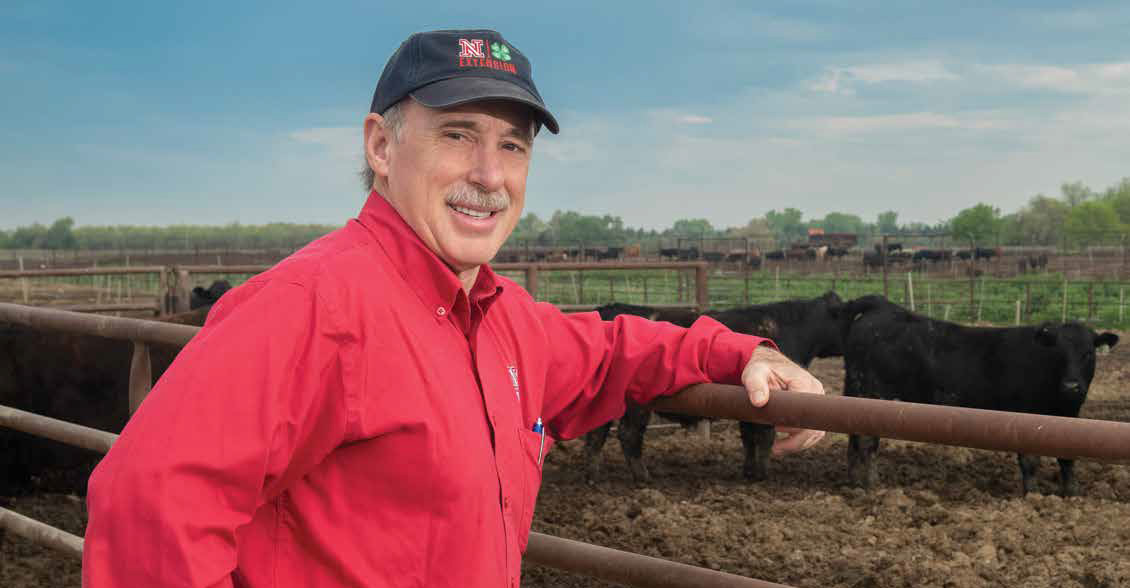
Trending Upward: Manure Nutrient Management
Manure as a Valuable Resource and More Natural Option

Manure is a valuable resource and a natural key piece to the biological cycle. Manure contains key nutrients that can be used in place of fertilizer on crops for a more natural option. Nebraska has the key advantage of recycling manure nutrients by having sufficient cropland next to the livestock sectors. According to Rick Koelsch, professor in the Department of Biological Systems Engineering at the University of Nebraska–Lincoln, Nebraska has an advantage over many other livestock producing regions because of its livestock and crop production capacity.
Recycling manure was highly valued before the popularity of commercial fertilizer. “I think my grandfather knew the importance of manure recycling because he didn’t have the alternative of using commercial fertilizers,” Koelsch said.
Koelsch works to communicate the importance of using manure as a valuable resource, instead of seeing it as a waste product. Manure is commonly used in place of fertilizer, but the two have distinct differences.
A Complimentary Relationship
Both manure and fertilizer have important advantages. Complimentary use of both fertility sources can be used to our advantage. According to Koelsch, the organic nitrogen in manure is released at a slow rate through the growing season. The organic material decomposes through the growing season to release the nitrogen more closely timed to season crop needs.
The slow release of nitrogen is beneficial because it reduces leaching risk, Koelsch said. Leaching is movement of nitrogen through the soil. Once the nitrogen moves beyond the roots of a crop, the crop can no longer use the nutrient. Fertilizer nitrogen is readily available following application and in a form that can leach.
For manure nitrogen to achieve this environmental advantage, it must be applied at a rate that matches the crop requirement. Precision application of fertilizer nitrogen has been a historical advantage of commercial fertilizers. Improving manure application equipment and fertility programs that integrate fertilizer and manure — and their individual advantages — can produce environmentally friendly results.
Aside from the environmental benefit, Koelsch said the economic value of manure is also notable, depending on the hauling distance. Especially for dry and composted animal manure, longer haul distances are proving economical for fields that utilize all of the manure’s components (particularly nitrogen, phosphorus, potassium and carbon).
According to Koelsch, the economic value is dependent on two factors: 1) which nutrients an individual field requires and 2) the proximity of the manure options available. The farther away the farming operation is from the livestock manure, the less affordable the manure is due to the cost of hauling.
However, Koelsch said most farmers can afford to haul drier manures 10+ miles and slurry manures a few miles, before the cost of hauling begins to outweigh the economic values. Although hauling manure can be a challenge, Koelsch said that manure should be valued for its fertility, soil health improvement, yield benefit, and even its environmental benefits.
Manure Nutrient Management is All About Recycling
Koelsch explained that manure nutrient management is connecting a biological cycle. Farmers apply nutrients to cropping fields essential to crop growth. Farmers then feed corn and other products to their cattle because those nutrients are essential to cattle growth. The cattle eat the corn, utilizing 10 to 50% of the nutrients, and the unused nutrients are in the manure. Manure contains nitrogen, phosphorus and carbon, which are nutrients essential for crop production, thus completing the biological cycle.
“The animal is never going to recover all of the nutrients,” Koelsch said, so manure recycling becomes a natural piece of the process. The nutrients that the livestock do not recover need to be brought back to the cropping fields. If the livestock farmers do not return the nutrients through the manure to our cropland, the biological cycle has been broken and an environmental risk has increased dramatically.
Koelsch said that manure nutrient management works to recreate this recycle loop and doing so builds resiliency within agriculture and the environment.
A nutrient cycle of:
Corn > Livestock > Manure+Fertilizer > Corn
can be an environmentally and economically successful biological cycle.
A nutrient cycle of:
Fertilizer > Corn > Livestock > Waste Manure

is a broken biological cycle, burdened with environmental and, possibly, economic risks.
“Manure nutrient management is all about recycling manure as nutrients — the nitrogen and the phosphorous and the carbon — as efficiently as we can,” Koelsch said.
Capitalizing on the Nebraska Advantages
Nebraska has an advantage in manure nutrient management over other areas across the nation due to the proximity of both crop operations and cattle operations. Koelsch said that Nebraska should not take manure for granted because manure provides significant benefits, if recycled efficiently.
“Nebraska has a very strong cropping sector and livestock sector in the same proximity,” Koelsch said. “We’ve the ability to recirculate nitrogen, phosphorus and carbon through our agricultural systems, unlike many other livestock intensive places.”
Nitrogen, phosphorous and carbon are key elements in farming, Koelsch explained. Nitrogen and phosphorous are primary nutrients for the growth of a crop. Nitrogen is the main nutrient absorbed by plants and helps form the crop’s protein, and phosphorus is essential to many essential plant processes. Carbon is another primary nutrient in manure critical to the health of soils.
According to Koelsch, manure adds to many soil physical and biological processes, leading to improved water infiltration rates, greater water storage, reduced soil erosion, and increased nutrient cycling.
“Carbon is essential for healthy soils,” Koelsch said. Carbon is important because it feeds the bacteria in soil. According to Koelsch, the soil bacteria produce “sticky glue” that forms soil aggregates. Aggregation occurs when the soil sticks together and produces clumps of soil increasing water infiltration into the soil, reducing runoff, and increasing soil storage of water for thirsty crops. This process helps protect fields against drought. Soil aggregates are also more stable and less prone to erosion.
Obtaining the Greatest Value
According to Koelsch, there are three main challenges with manure nutrient management.
First, knowing how much manure to apply to a field is essential to successful management. Koelsch explained that manure is a mix of both readily- and not-so-readily available nutrients. He also said it is a challenge to predict how much nitrogen is going to be available from the manure and how much the farmer can restrict fertilizer application.
Second, Koelsch said the odor released when spreading manure is a concern for neighboring farms. Manure odor can be carried by the wind to neighbors. Farmers can help prevent this by incorporating manure into the soil or, for surface-applied manure, being conscious of wind direction and speed, spreading manure only when weather conditions are right.
Finally, Koelsch said that compaction in the soil can result from the heavy manure application equipment. Compaction causes the soil to be less permeable by air and water. Avoiding use of application equipment on wet fields will minimize this risk. And previously discussed soil biology processes are working around the clock to reduce compaction.
Ultimately, manure nutrient management is vital to maximize the benefits of our agricultural resources, Koelsch said. Using manure promotes a healthy biological cycle with economic and environmental benefits to be gained from using manure.